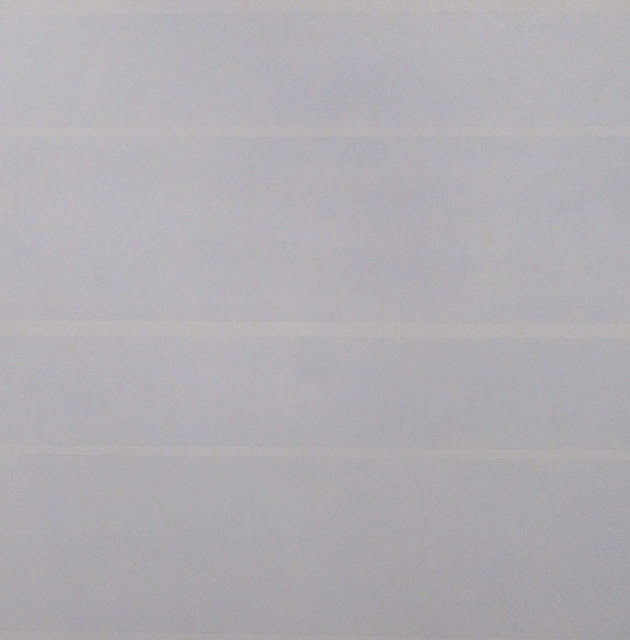Agnes Martin at Tate Modern.
It was such a pleasure a while ago when we were at Tate Modern to come across some of Agnes Martin's abstract paintings. I first came across Martin's paintings in New York at the Whitney Museum of American Art in 2012. I was bowled over. I have since seen more of her work, notably at Tate Modern again in 2015 where I have written a full analysis of her work and life. I also saw some of her work at the Hugh Lane in Dublin.
Her work invites contemplation, reflecting on perfection, beauty and spirituality. Her work was influenced by Zen Buddhism and Chinese Tao philosophy. Her paintings explore the inner emotional world and the human desire for peace and serenity. She considered art to be a transcendent experience. 'Beauty is the mystery of life. It is not just in the eye. It is in the mind. It is our positive response to life', she said.
The paintings in this post consist of horizontal bands of colour, divided by delicate pencil lines. The bands initially appear uniform, but on closer inspection, faint brushstrokes and pools of paint emerge. These marks give the artworks a hand-made feel, undermining the rigid geometry of the composition. As she said: 'the work is about perfection as we are aware of it in our minds but... the paintings are very far from being perfect - completely removed in fact - even as we ourselves are'.
This work is one of the last six-foot square paintings Martin made. It is also one of the final works she produced from her home in Galisteo, New Mexico, where she lived for 25 years. Martin was inspired by Chinese Tao philosophy and the vast desert landscapes that surrounded her. She said: 'I want people, when they look at my paintings, to have the same feelings they experience when they look at landscape. It's really about the feeling of beauty and freedom'.
Martin used a short metal ruler and masking tape to create her lines. She applied the paint in vertical stripes, rotating the canvas by 90 degrees once the paint was dry. She explained: 'you can't put it horizontally, it would drip down'. Despite her use of a ruler, the lines Martin produced are not rigidly straight. They trace the texture of the linen canvas, creating an undeniably hand-drawn quality.
Faraway Love, 1999, (acrylic paint and graphite on canvas)
Faraway Love, 1999, (acrylic paint and graphite on canvas)
Before 1993, Martin used a six-foot square canvas for her paintings. This size appealed to her for its enveloping relationship with the viewer's body. She saw it as 'a size you can walk into'. Martin found the large canvas increasingly difficult to handle as she grew older. She made the decision to reduce the size to a five-foot square. This canvas still takes up most of the viewer's visual field, allowing them to absorb the subtle variations in line, tone and texture without distraction. Something that is, alas, impossible to do when looking at a computer screen.
Martin applied an opaque base coat of white acrylic gesso (or primer) to this work. The gesso was overlaid with stripes of diluted blue and peach acrylic paint. The layered application of materials creates a translucent and light-reflecting finish. Graphite pencil is used to demarcate the coloured stripes. The paint strays beyond the pencil lines, giving the work a gestural and hand-made feel when viewed at close range.





No comments:
Post a Comment